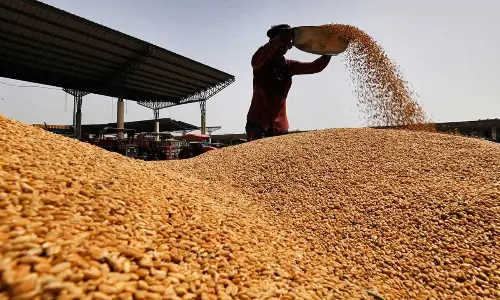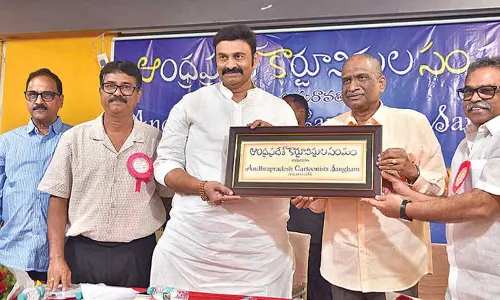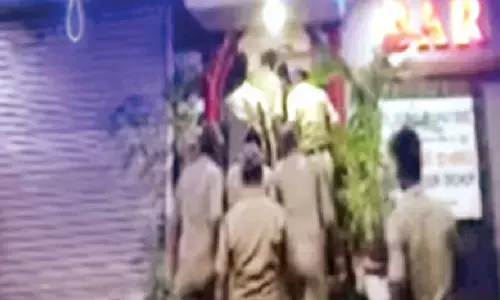Seema’s rising voices

Non-political voices from Rayalaseema are going unheard. The high publicity accorded to agitation for united Andhra Pradesh is not accommodating reasons and justification against this ‘united AP’. While Telangana established its resistence to Andhra exploitation, Rayalaseema is now voicing similar reasons. U Sambasivarao, coordinator of Telangana-Andhra Coordination Committee, took the initiative to coordinate non-political organisations’ views to present the positive side of the division proposals and brought them on to communicative stage. He supported the demand for Telangana for historical, cultural and geographical reasons.
Rayalaseema BC Medhavula Forum headed by Dr Naganna and others justified that with four districts Rayalaseema could survive as a distinct State
Non-political voices from Rayalaseema are going unheard. The high publicity accorded to agitation for united Andhra Pradesh is not accommodating reasons and justification against this ‘united AP’. While Telangana established its resistence to Andhra exploitation, Rayalaseema is now voicing similar reasons. U Sambasivarao, coordinator of Telangana-Andhra Coordination Committee, took the initiative to coordinate non-political organisations’ views to present the positive side of the division proposals and brought them on to communicative stage. He supported the demand for Telangana for historical, cultural and geographical reasons.
Like Telangana, Rayalaseema also suffered. Rayalaseema people did not want to continue with Andhra prior to 1953. Andhra leaders came up with some assurances to bring in Rayalaseema people to separate State. The main features of the 1937 Sribagh agreement are: Building a dam at Sidheshwaram in Kothapalle Mandal of Kurnool to divert Krishna river waters to dry lands of the region, establishing Andhra University in Anantapur and Kurnool to be the capital of Andhra State. Andhras also used slogans of ‘self-respect’ and ‘one State for one language’ to woo the Seema people. Andhra University was coolly taken to Visakha and Sidheswaram was displaced by Nagarjunasagar Project. Kurnool as a capital city was a three-year tamasha.
Kotipalli Radhakrishna Murthy Yadav, BC leader from Guntur, faulted Andhra leaders for this fiasco. He said though Rs. 1. 9 crore was given by the Centre for constructing a capital city in Kurnool, administration was run from military tents for around three years. They knew in 1953 that they would annex Hyderabad; and thus denied Kurnool its status of capital.
Dr Naganna, General Secretary, Rayalaseema Samajika Nyaya Party, sought ‘Rayalaseema State’ as the only solution to problems of the region. Bojja Dasaratha Rami Reddy, Secretary, Rayalaseema JAC, said that their region was given much less than the Krishna river water allotted to it. He alleged that Andhra was taking 377.7 tmc instead of its rightful share of 99 tmc.
The contention of Rayalaseema is similar to that of Telangana, as 75% of irrigated land in these two regions gets water at their own cost by using electric power to pull from underground for single crop in a year with great difficulty, while Andhra’s 75% of irrigated land gets water at the cost of State for three crops through major irrigation dams. Like in Telangana, a belt of medium tanks and ponds of water are used to nourish agricultural fields in Rayalaseema also. Such a tank-dependent agriculture was 49% in Rayalaseema during 1960-61 which by 2011 got reduced to just 9%. The reason is that the State did not allot even a single rupee for maintenance of tanks both in Telangana and Rayalseema, which resulted in increased dependency on bore wells with power consumption. Even if the so-called Jala Yagnam is completed, Seema leaders claimed that only 29% of land in their region would be irrigated while it aimed at 94% in Andhra. This, they say, is the ‘benefit’ that Seema got for being with Andhra in the ‘integrated’ State.
They opposed proposed division of Rayalaseema, and recognized the agitation for Telangana as genuine. Dr Naganna asked why Krishna-Pennar Project was cancelled and Nagarjuna Sagar was implemented. This change of project is the reason for desertification of Rayalaseema. Similarly, Telangana’s Pochampadu major dam on the Godavari was downsized to make Nagarjuna Sagar a major multipurpose irrigation project of the State, which inundated Nalgonda lands and irrigated Andhra’s (Guntur onwards) lands, as the dam was built on the borders of Nalgonda. Andhra leaders are provoking people to protect their vested interests in Hyderabad, says Mr Reddy.
Rayalaseema BC Medhavula Forum headed by Dr Naganna and others justified that with four districts Rayalaseema could survive as a distinct State. Counting on population of 1.5 crore, Rayalaseema will be bigger than 10 States and six Union Territories. It is richer in mineral resources such as gold, diamonds, uranium, copper, iron, limestone, barites, silica, asbestos which is not properly exploited by the state leadership but allocated to mining mafia. If productive industries are planned using this raw material, Rayalaseema can offer wide employment resources and usher in economic development.
The BC Forum has alleged that all those who fought against backwardness of Rayalaseema in 1983 were silent after gaining individual benefits and abandoned the region in poverty. The forum was perplexed at the variety of demands, such as merging Anantapur with Karnataka, dividing Rayalaseema into two and attaching two districts each to Telangana and Andhra, or making Rayala Telangana, or greater Rayalaseema, emanating from some irresponsible leaders, who never bothered about the identity, culture, history and sentiments.
(The writer is Professor & Coordinator, Center for Media Law & Public Policy, NALSAR University of Law, Hyderabad)




















